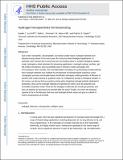Hydrogel microparticles for biosensing
Author(s)
Hill, W. Adam; Le Goff, Gaelle; Srinivas, Rathi L.; Doyle, Patrick S
DownloadDoyle_Hydrogel microparticles for biosensing.pdf (1.626Mb)
PUBLISHER_CC
Publisher with Creative Commons License
Creative Commons Attribution
Terms of use
Metadata
Show full item recordAbstract
Due to their hydrophilic, biocompatible, and highly tunable nature, hydrogel materials have attracted strong interest in the recent years for numerous biotechnological applications. In particular, their solution-like environment and non-fouling nature in complex biological samples render hydrogels as ideal substrates for biosensing applications. Hydrogel coatings, and later, gel dot surface microarrays, were successfully used in sensitive nucleic acid assays and immunoassays. More recently, new microfabrication techniques for synthesizing encoded particles from hydrogel materials have enabled the development of hydrogel-based suspension arrays. Lithography processes and droplet-based microfluidic techniques enable generation of libraries of particles with unique spectral or graphical codes, for multiplexed sensing in biological samples. In this review, we discuss the key questions arising when designing hydrogel particles dedicated to biosensing. How can the hydrogel material be engineered in order to tune its properties and immobilize bioprobes inside? What are the strategies to fabricate and encode gel particles, and how can particles be processed and decoded after the assay? Finally, we review the bioassays reported so far in the literature that have used hydrogel particle arrays and give an outlook of further developments of the field. Keywords: Hydrogel; Biosensor; Microparticle; Multiplex assay
Date issued
2015-02Department
Massachusetts Institute of Technology. Department of Chemical EngineeringJournal
European Polymer Journal
Publisher
Elsevier BV
Citation
Le Goff, Gaelle C., et al. “Hydrogel Microparticles for Biosensing.” European Polymer Journal, vol. 72, Nov. 2015, pp. 386–412.
Version: Author's final manuscript
ISSN
0014-3057